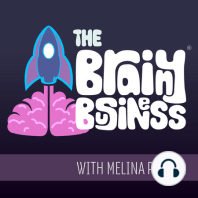33 min listen

21. Habits: 95% Of Decisions Are Habitual - Which Side Is Your Business On?
FromThe Brainy Business | Understanding the Psychology of Why People Buy | Behavioral Economics
21. Habits: 95% Of Decisions Are Habitual - Which Side Is Your Business On?
FromThe Brainy Business | Understanding the Psychology of Why People Buy | Behavioral Economics
ratings:
Length:
50 minutes
Released:
Nov 9, 2018
Format:
Podcast episode
Description
Habits are much more powerful than most of us realize. This behavioral economics podcast is about habits and habitual buying. It is another one of my behavioral economics foundations podcasts. When a lot of us think of habits, we focus on bad habits, but we actually have more good habits than bad. Our subconscious does about 99% of the brain’s processing and this applies to habits and buying habits. I am going to break this down for you to make sure it is super applicable for your business – including the different strategies you should use if you are the market leader versus someone trying to break in. They are very different! I also talk about how businesses make the mistake of focusing on what’s new instead of the habitual buying habits, and how you can use buying habits to improve your business and marketing. CLICK THE IMAGE FOR YOUR FREE DOWNLOAD! Show Notes [09:00] The subconscious brain does about 99% of the brain’s processing. [09:41] If 99% of decisions are made using these automatic rules, based on the way things have been done in the past and what has worked…clearly a lot of the buying decisions you (and your customers) make must be done automatically. [11:01] Even with infrequent purchases, the place you go and look is based on habit. [11:50] An association in the brain that triggered an action (or a desire to take an action). That is essentially all a habit is. [12:17] The human brain essentially works on many, many associations. [13:29] Your brain sorts through tons of information and concepts – all the things it is NOT looking for until it finds what it is looking for. [14:49] In reality, 95% of all buying decisions are HABITUAL. Far too many companies and brands are focusing on the 5% - the “new” and “different” and “getting people to consciously make a decision and change” than working on being in the 95% of habitual purchases. [16:33] What is a habit? The official definition is “a settled or regular tendency or practice, especially one that is hard to give up” [18:23] Maltz, a plastic surgeon in the 1950s noticed it took about 21 days for his patients to get used to their new noses. [18:48] His book Psycho-Cybernetics said, “These, and many other commonly observed phenomena tend to show that it requires a minimum of about 21 days for an old mental image to dissolve and a new one to jell.” [19:15] NOTE: He said a minimum of about 21 days. [20:28] Our brains have a habit of using the 21 days as a reference even though there's a mountain of evidence against it. [20:54] We have been attacking habits wrong. [21:55] A 2009 study from The European Journal of Social Psychology found the average number of days it took to form a habit (in their case it was eating fruit at lunch or running 15 minutes a day) was 66. [22:17] This is where framing can kill you. You hear an average and think great that's the number. [22:40] There are more questions that you need to ask. Such as what was the range of days when coming up with that average. The range for this study was 18 to 254 days. [24:57] Essentially, all habits are made up of four phases: Cue, Craving, Response, and Reward. [25:41] The human brain is driven by rewards. [26:24] A cue is a signal to the brain that there is a reward around. And that instantly leads to a craving. [26:50] Cravings can be hard to ignore. It can quickly become all your conscious brain can focus on. [27:03] When you give in to the craving and the brain gets the reward, you have a double whammy because you have just reinforced the original cue to make it even more powerful the next time. [27:42] The thing we have done WRONG in addressing habits in the past is to try and change the response. [27:59] If you want to change a habit or start a new one, the CUE and REWARD phases are where it’s at. [28:44] To help stop doing something you need to find the cues that encourage you to do it. [29:27] Cues have been found to fall into one of five categories: Location, Time, Emotional State, Other People, and
Released:
Nov 9, 2018
Format:
Podcast episode
Titles in the series (100)
14. Scarcity: Why We Think Less Available Means More Value: Fall is a favorite season of mine and probably a favorite season to many of you. It’s also the time of year that my favorite honeycrisp apples are available. Like cotton candy grapes, these apples benefit from scarcity. Today, I break down what... by The Brainy Business | Understanding the Psychology of Why People Buy | Behavioral Economics